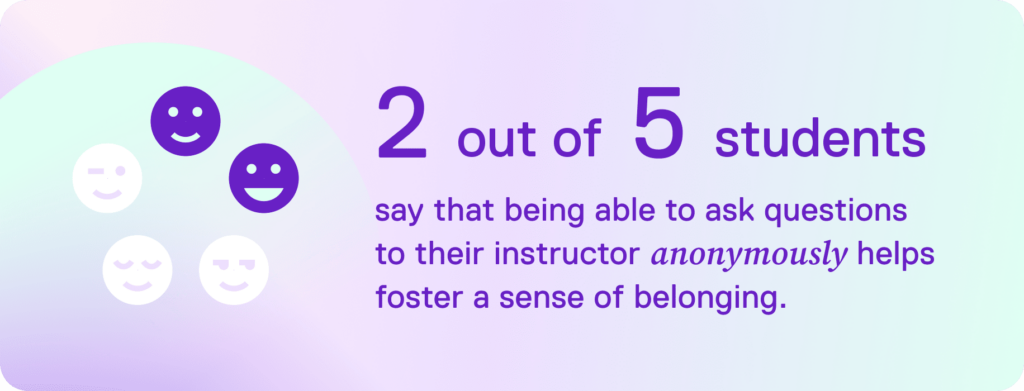It’s that time: the days are becoming shorter, temperatures are beginning to dip and more importantly, educators and students have returned to the classroom. At Top Hat, we recognize the value of ensuring every student comes to class prepared and excited to learn. We recently surveyed more than 21,000 students who used Top Hat in the Spring 2024 term about the impact our engagement platform and content solutions had on their academic journey. From interactive readings to in-the-moment study support, here’s how Top Hat made a tangible difference in their studies.
Greater preparedness = better retention

When students arrive to class feeling prepared, they’re more likely to persist. Data from the American Council on Education and the School of Education and Information Studies at the University of California at Los Angeles backs this up. The report finds that three out of five students surveyed state academic underperformance drove their decision to leave college for more than one term.
Faculty have made tremendous strides in providing opportunities for frequent, low-stakes knowledge checks during the term. The emphasis on bite-sized assessments hasn’t gone unnoticed among students. “Real-time quizzes and polls not only helped reinforce key concepts but also encouraged active participation among students. Top Hat has truly enhanced our classroom interaction and made learning more enjoyable,” says Muhammad Ali Gajani at Indiana University Bloomington.

Students bring an array of opinions and interests to your course. It’s why they value the opportunity to be active participants in the classroom. Research also shows that students who learn using active learning methods perform better on tests than those who sit in long-form lectures. Students echoed the impact Top Hat’s interactive polls, quizzes and discussions had when applying their knowledge. “Top Hat helped me perform better in my class as well as apply my understanding to my homework and exams,” shares Jacob Purcell at West Texas A&M University. An anonymous student from Texas State University at San Marcos chimes in. “It helped me to pay attention and stay engaged, getting me a better grade.”
Turning static readings into an interactive experience
We hear from educators that students don’t always complete their reading assignments before class. Over the years, students have tried to take shortcuts to their readings by searching for online summaries. How have educators responded? For starters, they’ve chosen to create ‘snackable’ content with media and real-world case studies that reflect an ever-changing world. Faculty have also relied on Top Hat’s personalized and interactive content solutions to ensure students have opportunities to read and then apply their understanding of concepts in the form of embedded polls and discussions.

No matter discipline, students have responded favorably to using Top Hat titles in their course. “I loved the interactive aspect of my Top Hat textbook. Engaging with models, watching videos, and answering questions in chapters was really interesting and valuable to my learning experience,” shares an anonymous student at the University of South Dakota. Learners also appreciate the digestible nature of Top Hat Interactive eTexts. “With Top Hat, I felt that I could easily understand the information and stayed focused throughout my reading for the first time,” shares an anonymous student at Northern Virginia Community College.
Making participation less intimidating

Raising your hand in a large class can come with a good deal of intimidation. Students place increased importance on asking questions anonymously and without fear of judgment. It’s why millions of students have flocked to Generative AI platforms such as ChatGPT for instant study guidance. Educators have tapped into the heightened interest in AI and have shared ethical use principles with students. Some faculty have even allowed students to build off content generated by a Large Language Model. For instance, English professors may let students use ChatGPT to form a thesis statement for an essay and ask them to critique the strengths and weaknesses of the generated response.

More than 630 of our survey respondents used Top Hat Ace, our AI-powered teaching and learning assistant, in the Spring term. Their comments revealed three primary ways that they relied on Ace through the course of their study.
- Provide clarity: Students valued receiving clarification on challenging concepts covered in lecture or while reading their assigned text. “I liked that [Ace] asked a thought-provoking question after answering to promote continuous understanding of the topic, not just giving me the answer,” shares an anonymous student at Oakton Community College.
- Personalize study support: Students often relied on Ace for course-specific guidance when completing homework. The best part: since responses are built from the context of the course, students feel like they’re learning along the way versus being handed answers. “I love Ace! I would ask questions and Ace always believed in me that I could answer the question on my own so it would just recommend a section of the module to re-read,” says Nazli Kircicek at McGill University.
- Assess knowledge on the fly: Several students highlighted how Ace allows them to reduce their knowledge gaps in advance of tests. Many also used Ace as a tool to apply their understanding of concepts in a low-stakes, low-stress environment. “Ace was able to create sample exam questions relating to the content we were learning in class to prepare for exams during lectures,” shares an anonymous student at Grand Valley State University.
→ New Ebook: FREE strategies to use AI effectively in any course


